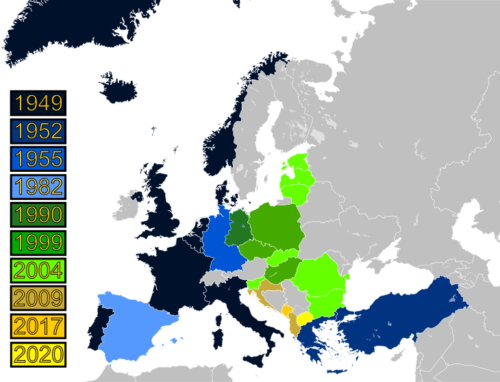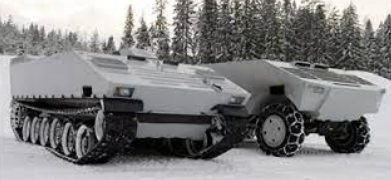(HTML version) by Charles Knight, Common Dreams, 14 April 2003. On 17 April 2003 Howard Dean replied on Common Dreams.
U.S. Defense Policy
9/11 and the Meanings of Military Transformation
(HTML version) (PDF version) by Carl Conetta, Project on Defense Alternatives, 06 February 2003. This article examines a ten-year failure to adapt US security policy to post-Cold War realities and assesses how well three different concepts of military transformation correspond to these new realities. Originally published in Security After 9/11: Strategy Choices and Budget Tradeoffs by the Security Policy Working Group, January 2003 (.pdf file). A compilation of eight articles that gauge the cost and effectiveness of post-9/11 US security policy offering assessments of counter-terrorism, homeland security, and military transformation policies in light of alternative options and budget tradeoffs. Executive summaries and author contact information included.
Essential Elements Missing in the National Security Strategy of 2002
(printable PDF version) (HTML version) by Charles Knight, PDA Commentary, November 2002. For an official document of the U.S. government, the Bush National Security Strategy of 2002 is disturbingly insubstantial, ideological, and, at times, disingenuous.
The “New Warfare” and the New American Calculus of War
(HTML version) by Carl Conetta, PDA Briefing Memo #26, 30 September 2002. US methods of warfare have changed substantially since the Cold War’s end. So have the norms governing the use of force. Since 11 September 2001 there has been an increased impetus to more fully exercise US military primacy and test the promise of the new warfare. Unfortunately, this impetus has not been matched with adequate analysis of either the new methods or the new norms of war.
Terrorism, World Order, and Cooperative Security: A research and policy development agenda
(HTML version) by Carl Conetta. PDA Briefing Memo #24, 9 September 2002. The war on terrorism is transforming US policy and reshaping global politics. But public debate regarding the campaign — its strategy and progress — has been feeble. Likewise, the evaluation of new programs and spending meant to support it has been superficial. This evinces the fact that US policy discourse itself suffered a serious blow on 11 September 2001. The article outlines areas and issues of concern.
The Pentagon’s New Budget, New Strategy, and New War
(HTML version) by Carl Conetta. PDA Briefing Report #12, 25 June 2002. Examines the new US military strategy as codified in the September 2001 Quadrennial Defense Review and practiced in the Afghan war. The report contrasts the new QDR with its 1997 predecessor, paying special attention to the Bush administration’s “new concept of deterrence.” Published in Hegemonie oder Stabilität: Alternativen zur Militarisierung der Politik, edited by Volker Kröning (MdB), Lutz Unterseher, and Günter Verheugen (Hrsg.) Bremen: Edition Temmen, August 2002.
Bush Administration Policy Toward Europe: Continuity and Change
(printable PDF version) (HTML version) by Charles Knight, January 2002. The demise of the Oslo peace process in 2001 and a likely renewal of intense war with Iraq in 2002 or 2003 will play very differently on each side of the Atlantic. In certain circumstances the differences might be so great that European powers would feel compelled to reject American leadership and pursue a separatecourse. Published in Hegemonie oder Stabilität: Alternativen zur Militarisierung der Politik, edited by Volker Kröning (MdB), Lutz Unterseher, and Günter Verheugen (Hrsg.) Bremen: Edition Temmen, August 2002.
A Response to Ivan Eland’s “Bush Versus the Defense Establishment” in Issues in Science and Technology Forum, Fall 2001
(HTML version) by Charles Knight, PDA Commentary, Fall 2001. The most profound effect of new technologies in military affairs is not an expanding choice of hardware but rather the opportunities technological developments provide to reorganize the way humans do their military work.
What Justifies Military Intervention?
(HTML version) commentary by Charles Knight, 27 September 2001. Examines the problems for international security associated with U.S. military intervention abroad. Includes a Postscript on the “war on terrorism” (revised 01 March 2002) and Selected Readings on the doctrines of Just War, Total War, and Strategic Bombing (revised 01 March 2002).
A New US Military Strategy: Issues and Options
(HTML version) by Carl Conetta and Charles Knight, PDA Briefing Memo #20, May 2001. Reviews the principal strategy debates of the 1990s with an eye toward the options under consideration by the Bush administration.
Disengaged Warfare: Should we make a virtue of the Kosovo way of war?
(HTML version) by Carl Conetta, PDA Briefing Memo #21, May 2001. Offers a critical perspective on “strategic precision attack” in US warfighting plans and doctrine, tracing this tenet to “risk aversion” and America’s diminished stake in distant conflicts. While the concept of “strategic precision attack” promises to avert battlefield risks, this memo argues that in the end it transplants the risk to the strategic level.
The Paradoxes of post-Cold War US Defense Policy: An Agenda for the 2001 Quadrennial Defense Review
(HTML version) PDA Briefing Memo #18, 05 February 2001. Recent defense planning discussions have tended to focus on military readiness and modernization issues, but a broader purview is needed and must address three persistent paradoxes of post-Cold War US defense policy.
Concepts for Army Transformation: A Briefing for the Transformation Task Force
by Col. Douglas A. Macgregor, 2001. PDF
Col. Macgregor offers a vision of a modular Army comprising various types of basic combined-arms units that would be much smaller than today’s divisions, but larger and more capable than today’s brigades. This is an Army that is not only rapidly-adaptable and rapidly-deployable but also “joint” and “combined” from the bottom up.
Bigger Budgets Will Not Cure the Pentagon’s Ills
(HTML version) by Carl Conetta and Charles Knight, op-ed in the Boston Globe, 08 October 2000. Traces recent Pentagon problems to a failure to implement defense reform and adapt to the conditions of the new era. A short bibliography of relevant online material (with links) is included.
Can the United States Spend Less on Defense? — Toward a Smaller, More Efficient, and More Relevant US Military
(HTML version) PDA Briefing Memo #17, October 2000. Examines issues of threat assessment, strategy, and force management, identifying options for moving toward a smaller, less expensive US military. It concludes that in several ways current US strategy is unnecessarily ambitious and that the armed forces are poorly adapted to present day needs. It suggests adjustment in several areas, including regional war preparations, military presence abroad, and the diplomatic activity of the US military. The memo also proposes a variety of structural reforms to increase the efficiency of the armed forces.
The Armed Forces: “used too much and supported too little”?
(HTML version) by Charles Knight, PDA Commentary, September 2000. George W. Bush campaigned for the presidency saying the “military suffers from back-to-back deployments, poor pay, shortages of spare parts and equipment, and rapidly declining readiness.” In evaluating this claim it is worth examining each of the four specifics that Governor Bush offered as evidence. This commentary provides a guide to the pertinent evidence as collected, organized, and analyzed by the Project on Defense Alternatives in its 1999 study of readiness issues in the Air Force.
Wheels or Tracks? On the “Lightness” of Military Expeditions
➪HTML Lutz Unterseher, PDA Briefing Memo #16, July 2000.
U.S. Military-Strategic Ambitions — Expanding to Fill the post-Soviet Vacuum
(HTML version) by Charles Knight, PDA Commentary, adapted from a panel presentation at the Council on Foreign Relations, N.Y.C, 14 June 2000. When seeking to explain why defense budgets are growing again, it is often said that U.S. policy-makers have not yet moved beyond the Cold War frame and are preparing for the proverbial “last war.” Such a vantage glosses over an important change that has taken place in the last decade. The new national defense policy is not simply a lesser version of the old policy. Rather, its security goals are very much more ambitious than during the Cold War and these ambitions drive budgets higher.
Europe’s Armed Forces at the Millennium: A Case Study of Change in France, the United Kingdom, and Germany
(HTML version) by Dr. Lutz Unterseher, chair, International Study Group on Alternative Security Policy (SAS), PDA Briefing Report #11, December 1999. Many European nations are re-thinking their post-Cold War military requirements in light of NATO’s new strategic concept and the experience of the Kosovo war. This article analyzes the process of defense restructuring and modernization in France, the United Kingdom, and Germany. In each case, it offers an overview of current military posture and closely examines the plans for change in force structure, equipment procurement, and personnel policies, attending to various constraints on defense planning, including military traditions, economic conditions, and domestic politics.
Evaluating the Post-Cold War Policy of the United States
(printable PDF version) by Ambassador Jonathan Dean, Adviser on International Security Issues, Union of Concerned Scientists, presentation to the PDA symposium Ten Years After the Wall:Trends in post-Cold War U.S. Security Policy held at the American Academy of Arts and Sciences, 11 November 1999.
Don’t Court Disaster In Iraq
(HTML version) by Alan J. Kuperman, November 1999. This commentary replies to an advocate of U.S. support for military insurgency against the regime of Saddam Hussein in Iraq. The author finds this extension of the Reagan doctrine unconvincing in its intended effect and a danger to regional stability. Originally appeared as a letter to the editor of the Wall Street Journal on 18 November 1999.
Alleged ‘Carrier Gap’ is Out to Sea
(HTML version) by Carl Conetta and Charles Knight, PDA Briefing Memo #15, 30 April 1999. The April 1999 re-routing of aircraft carriers to support operations in the Persian Gulf and the Balkans inspired alarm about the effect of the move on America’s military presence in the Pacific. However, the assertions of a serious gap in carrier coverage are groundless. Alarmism about redeployment misjudges the effect of the move on the military balance in Northeast Asia and betrays a disregard for the one feature of aircraft carriers — their flexibility — that is supposed to give them unique strategic value worthy of their prodigious cost.
The Readiness Crisis of the U.S. Air Force: A Review and Diagnosis
(HTML version) (summary) by Carl Conetta and Charles Knight, PDA Briefing Report #10, 22 April 1999. By some accounts, the Air Force is suffering from a systemic readiness crisis brought on by a combination of post-Cold War defense retrenchment and increased operational activity. PDA’s examination of the Air Force’s recent readiness problems and of longer-term trends in readiness and optempo finds little to support this view. Neither talk of crisis, nor crisis spending are warranted.
Military Strategy Under Review
by Carl Conetta and Charles Knight, Foreign Policy In Focus, Volume 4, Number 3, 01 January 1999. HTML | PDF
“’Environment shaping’, the other ascendant element in the new strategy, prescribes a more active peacetime use of military power to influence the course of strategic affairs. It encompasses not only traditional deterrence, but also the goals of discouraging other nations from even trying to compete militarily with the U.S. and of ‘preventing the emergence of a hostile regional coalition or hegemon’ Key to achieving this novel “preemptory” deterrence is the maintenance of a robust U.S. regional presence, a daunting degree of U.S. military superiority, and a technological edge that no prospective competitor could hope to diminish.”
Nato Expansion: Costs and Implications
(HTML version) A presentation by Carl Conetta to the International Network of Engineers and Scientists for Global Responsibility, Cambridge, MA, USA, 23 July 1998. The expansion of NATO is as fateful an initiative as any undertaken in the past 200 years, calling to mind the decisions made at the 1814 Congress of Vienna and at Versailles in 1919. It is peculiar and disconcerting, then, that the questions this initiative inspires remain so elementary: Why expansion? And, To what effect? At what cost, financial and strategic?
Defense Sufficiency and Cooperation: A US Military Posture for the post-Cold War Era
by Carl Conetta and Charles Knight, Project on Defense Alternatives briefing report, 01 March 1998. ⇒ HTML ⇒ PDF
This study presents a comprehensive and coherent US military posture option for a fifteen-year period beginning in 1998. While maintaining continuity of key aspects of US security strategy, it finds ample opportunity for further reductions in forces size and consequently in budget. Includes specification of force structure, equipment holdings, deployment, modernization plans, and defense budgets.
Dueling with Uncertainty: the New Logic of American Military Planning

Examines how the new planning concepts and methods adopted by the Pentagon since 1992 have led to military requirements disproportionate to real threats and have supported overweening ambitions for the application of military power. A version appeared in the March/April 1998 Bulletin of the Atomic Scientists as “Inventing Threats.”
Wanting Leadership: Public Opinion on Defense Spending
(HTML version) by Carl Conetta and Charles Knight, January 1998. Since 1982 significantly more Americans have supported cuts in defense spending than have supported increases. After 1994, when President Clinton called for “no further cuts in spending,” the portion of Americans supporting increases has risen somewhat. Surveys uphold the key role of leadership in the formation of public sentiments about defense-related issues finding that a solid majority of the public would support relatively deep cuts in the Pentagon budget if the President and Congress proposed them.
Future Tense — An Assessment of the Report of the National Defense Panel
(HTML version) by Carl Conetta, 05 December 1997. Examines the National Defense Panel’s general recommendation for reducing emphasis on armed forces quantity in exchange for quality enhancements. While this recommendation makes certain sense, the NDP’s failure to specify cuts and its tendency to endorse new investments prematurely are problematic.
From the QDR to the NDP — A Summary of QDR Policy Issues Since May 1997 and the Likely Content of the NDP Report
(HTML version), Project on Defense Alternatives, from Reviewing Defense, Global Beat Working Paper #32, the Center for War, Peace, 14 November 1997.
America’s New Deal With Europe: NATO Primacy and Double Expansion
Including analysis relevant to the 2022 Ukraine crisis, this article addresses NATO expansion, burdensharing, the Balkans crisis, and relations with Russia and Germany. The American debate and public opinion regarding NATO enlargement is reviewed as well.
≡
Progress of NATO, 1949-2020

General Trainor’s Korean War Scenario is Only Half the Story
(HTML version) by Charles Knight, PDA Commentary, 04 June 1997.

